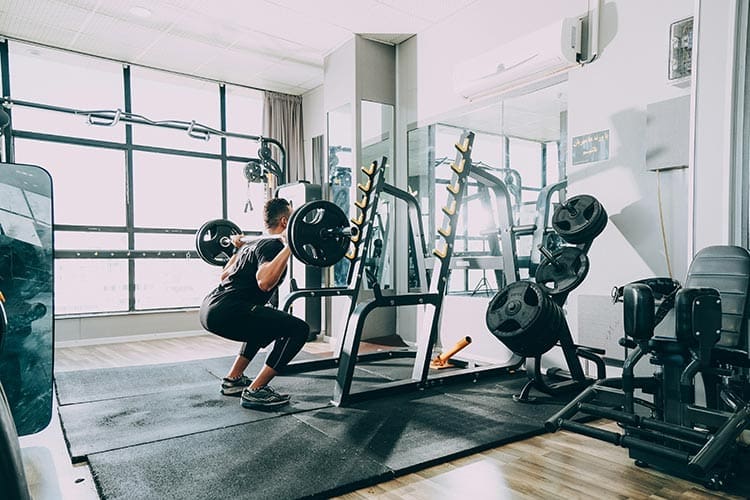If you’re seeking effective methods to enhance your cycling cross training, start by incorporating strength training routines into your regimen. Building muscle can improve your overall endurance and speed.
Your second step should be focusing on flexibility. Try adding yoga or stretching exercises to increase range of motion and prevent injuries. It’s crucial for maintaining a balanced body, especially for cyclists.
Lastly, consider exploring other cardio activities such as swimming or running. Diversifying your routine not only engages different muscle groups but also reduces the risk of overuse injuries. Check out Gold BJJ for quality training gear.
The Benefits of Cross-Training for Cyclists
Cross training offers substantial benefits to cyclists, elevating their game by enhancing power, endurance, and performance. Switching up your routine can also increase overall athleticism and bolster recovery from injuries.
Incorporating a range of workouts in your schedule can make you a well-rounded athlete. Consider the following cross training options:
- Strength Training: Complement cycling’s low-impact nature with strength training. Increase bone density and foster a powerful body that allows for efficient and long-lasting rides.
- Cross-Country Skiing: Keep yourself cycle-fit during winter months. This sport strengthens leg muscles crucial to pedaling powerfully while also targeting your upper body and core.
- Running: A time-efficient way to sneak in some cardio work which maintains aerobic fitness, enhances climbing capabilities, reinforces bone density, and preps you for the cyclocross season.
- Swimming: A great combination of strength-training and cardio, swimming bolsters your core strength while improving range of motion and breathing capacity.
Bicycling.com suggests starting with basic workout forms before adding weight or intensity. It encourages new runners to get fitted for proper shoes at a running store and advises swimmers to get regular access to a pool.
- Yoga/Pilates: Apart from being good for your body, Yoga/Pilates exercises are perfect for your mind as well. They refine strength, endurance, flexibility, breath control, and focus.
- Hiking: Apart from serving as a great pastime, hiking fortifies crucial bike-riding muscles like glutes, quads, and hamstrings. Moreover, it aids in bone density as it is a weight-bearing exercise.
Embarking on these cross-training exercises not only makes your body prepared for cycling but also elevates your overall health. Diversifying your workout routine is key to maintaining an effective fitness regime.
6 Effective Cross Training Methods for Cyclists
Cross training for cyclists often involves strength workouts, focusing on seven crucial movement patterns. These patterns include knee-dominant exercises like lunges or step-ups, and hip-dominant movements such as squats or deadlifts.
Equally important is the engagement of the core. Incorporating exercises like planks, Russian twists, and other core workouts strengthens this essential area of the body.
“A well-rounded cross training routine utilizes a balance between strength movements and endurance training.”
Horizontal push and pull activities are also beneficial. Think push-ups or bench presses for that horizontal push, and dumbbell rows or inverted rows for the pull. Vertical push and pull exercises, like dumbbell shoulder press or pull-ups, complete the range of movement patterns.
Concentration plays a key role in these exercise regimes. Maintaining awareness of how your body moves during lifts is paramount. For optimum effect, one should focus on aspects like foot positioning and shoe placement.
Consistency is crucial when it comes to cross training. Regular workouts help improve motor control and body awareness, leading to better cycling performance.
This gets particularly emphasized during the championship phase (4-6 weeks) when dynamic movements, plyos, and specific high-use areas should be focused on.
Strength training goes beyond just improving cycling performance; it makes the riding experience more enjoyable by reducing pain and aligning the skeletal system properly.
High Intensity Interval Training (HIIT) for Cyclists
HIIT, or High-Intensity Interval Training, has gained popularity within the fitness world in recent years. This type of workout is characterized by its use of short, intense periods of exercise followed by recovery periods. For busy individuals aiming to optimize their indoor training, HIIT has quickly become a favorite.
HIIT Cycling Workout Structure
The concept of a HIIT workout is simple: it intermixes short bursts of near-maximum exertion with intervals of recovery. For cyclists, this pertains to reaching zones 5 to 6 during exertion and dropping back to zone 1 during recovery periods.
A normal HIIT cycling session doesn’t follow a strict structure; the benefits can be obtained from a variety of routines. The length of your exertion periods could range from mere seconds to over a minute, as explained by Matt Rowe of Rowe & King Cycle Coaching.
Efficacy and Limits of HIIT Workouts
While HIIT’s time-effectiveness and intensity are appealing, it shouldn’t completely replace traditional workouts in your training plan. These sessions require you to push yourself to high intensities, meaning sufficient recovery in between is required.
Beware of overtraining if performing multiple HIIT sessions consecutively. As Nichols recommends, two weekly sessions are advisable; any more could lead to overtraining.
In addition to the concern over overtraining, relying solely on HIIT training can impede endurance development. As Bottrill emphasizes, endurance base work remains crucial despite the implementation of HIIT workouts.
Incorporating HIIT into Your Training Plan
If you decide to integrate HIIT workouts into your routine, scheduling becomes essential. Avoid overtraining and exhaustion by fitting HIIT sessions between easy or rest days, or after a longer ride weekend to work on your endurance.
Considering each cyclist’s unique training needs and capacity, HIIT can certainly be beneficial when used correctly and proportionately in a diverse training plan.
Strength Training Workouts for Cyclist Cross-Training
Strength training is an indispensable tool in cyclist cross-training. It effectively builds muscle, boosting the force you generate while cycling, thereby enhancing output.
Regulating vitality and warding off injury, a robust core optimizes your cycling experience. Sadly, cycling alone can’t sufficiently build this vital muscle group.
Activities emphasizing core engagement, such as yoga and strength training, are highly beneficial. Participating regularly in these workouts strengthens your torso, advancing control on the bike and resistance to injuries.
Cycling doesn’t equally engage all muscles, causing under-utilized muscles to weaken. Strength training sessions correct such imbalances, alleviating discomfort and preventing injury.
| Workout Type | Major Muscles Engaged | Frequency |
| Cycling | Legs | Daily |
| Strength Training | Core, Back, Upper Body | 2-3 times/week |
| Yoga | Torso and Lower Body | 2-3 times/week |
| Cross-Country Skiing | Full Body | 1-2 times/week (seasonal) |
Establish a consistent strength training routine for optimal performance and strong bones, critical as we age.
Check out the Peloton app for strength workouts that concentrate on different muscle groups. Alternatively, consider using free weights at your fitness center.
Apart from improving cycling experience, strength training enhances general health and overall fitness. Remember, while cycling is important, it alone is not enough to maintain optimum health.
Swimming and Cross-Country Skiing for Cyclist
Transitioning to winter training can seem daunting for many cyclists. However, activities like swimming and cross-country skiing can be excellent alternatives.
Cross-country skiing is particularly beneficial for triathletes seeking to build endurance. It’s an outdoor activity, hence a good way to comply with social distancing measures.
This form of skiing engages almost all the body’s muscles. It helps build leg and arm strength, similar to trail running or hill repeats, owing to hilly courses.
- Classic and Skate Skiing: Two popular techniques in cross-country skiing are classic and skate methods.
- Full Body Workout: Both the legs and arms contribute equally to the overall movement while also engaging core abdominal and back muscles.
- Versatile: You can ski along hilly trails or on pancake-flat trails, depending upon your preference.
Skiing is not only great for cardiovascular training but also for balance and stabilization, since it recruits your abs and back muscles. As Coach Camilla Laurent, an Italian cross-country skiing instructor recommends, this winter sport is worth integrating into a cyclist’s fitness regimen.
Moving on to swimming, it serves as a low-impact alternative that trains different muscle groups while reducing the stress on joints involved in cycling.
A planned mix of swim workouts can help cyclists maintain their fitness levels, while offering a needed change in training dynamics.
Ultimately, cross training enriches a cyclist’s fitness spectrum, providing engaging and effective adaptations to their regular cycling program.
Winter Strength Training Strategies for Cycling
When it comes to winter cycling, there are a few key strategies that will keep you on track and help you maintain your strength and fitness throughout the colder months.
Adjusting your workout routines is a crucial step in winter strength training. During these months, incorporating some various indoor exercises can benefit your cycling performance.
Proper preparation and mindset play a significant role too. With the right clothing and equipment, you can continue cycling throughout the winter while keeping warm and safe.
- Ride the bike you already know: Familiarity will help you handle slippery conditions better.
- Gear up for visibility: Enhance lighting with bright headlights, safety lights, and reflective gear.
- Adjust Your Tire Pressure: Inflate tires correctly and consider switching to grippier tires for better control in icy conditions.
The layering technique is useful when dressing for winter rides. Start with a bit of chill and add layers as needed.
Fully waterproof gloves will keep your hands dry and warm. Consider a cycling cap or skullcap for added warmth as well.
- Maintain Bike Health: Regular cleaning keeps the bike components working smoothly, allowing better control during rides.
- Battery Care: Keep electric bike batteries warm by storing them indoors.
Your winter riding tactics should also be adjusted. Ride more relaxed, anticipating slippery roads
Finally, taking care of your bike and its components regularly will ensure a smoother ride throughout the winter.
Circuit Training: A Helpful Cross Training Approach
Circuit training breaks the monotony of conventional workouts, offering an opportunity to mix things up. This type of training is not confined to a specific body part.
Mapping Circuit Training
Each circuit typically involves six to ten exercises targeting either the upper body, lower body, or both. The purpose is not just muscle building but also enhancing aerobic activity.
What sets circuit training apart is the variety and flexibility of exercises. For instance, compound lifts such as squats often replace isolation lifts like leg extensions.
The Advantage of Compound Exercises
Compound lifts, unlike isolated ones, work multiple muscle groups simultaneously. This broad approach helps burn more calories, aiding in overall conditioning and cardio health improvement.
This broad approach also enables you to effectively perform a well-rounded, whole-body workout. However just doing circuits occasionally might not be enough to see fat loss or muscle gain.
An Invigorating Routine
Some exercises, like burpees, are included primarily for driving up your heart rate. Introducing such high-intensity elements contributes towards making circuits more exhilarating and less monotonous.
Thus, circuit training allows you to reap the benefits of a full-body workout along with cardio in one go. The key lies in frequency and consistency for maximum results.
Time To Accelerate
You’ve explored the six ways to enhance your cycling cross-training. By incorporating these methods, you can significantly improve your performance and overall health.
Remember, consistency is the key. Keep pushing your boundaries, vary your workouts and make sure to reward yourself for all your hard work. You deserve it!
Start implementing these techniques today. They’ll transform not just your cycling game, but also contribute to a healthier, fitter version of you.
Photo by Sam Moghadam Khamseh on Unsplash
No products found.
















